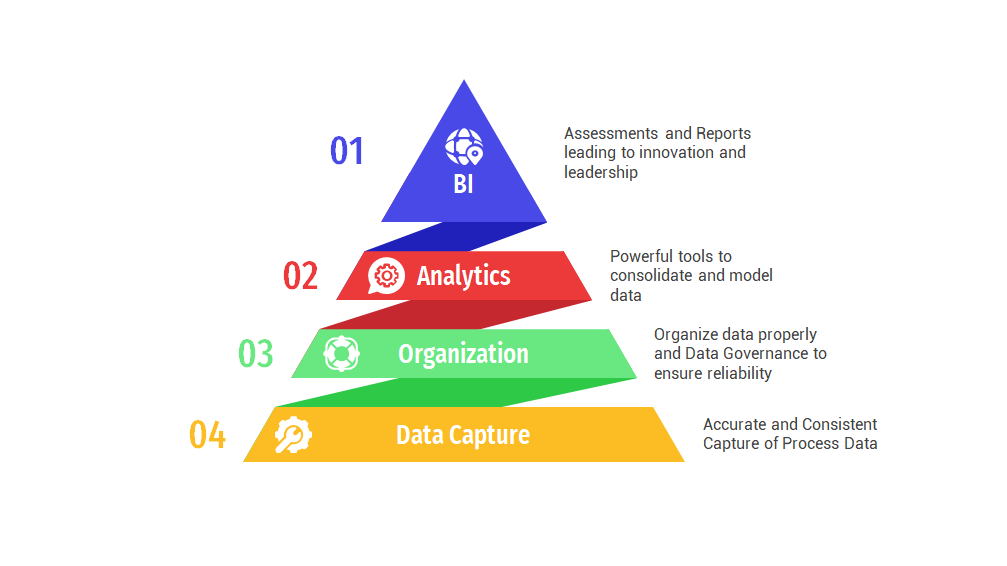
Introduction
A value-driven business process management strategy is essential to the success of a business. With an enterprise business process repository, the business can map out, design, execute, and improve business processes. A well-developed and managed repository will drive the organization to be efficient, innovate, and achieve its business objectives. How do we build an effective enterprise process repository?
A business process has numerous dimensions – people, policies and procedures, internal & external systems, transaction volumes, interactions with other processes, process calendars, and more. The process repository should be designed and developed such that the capture of all these data points is accurate, complete, and current. The data must be updateable. It must be governed effectively to ensure that it is consistent and up to date.

Populating the Repository
Process Discovery tools capture process data on-site. The data capture activity is a planned activity that is carried out over a period, to ensure accuracy and completeness of process data capture. @ NxtWorx Technologies, our Discover-Nxt service provides a highly automated methodology to populate the repository.
Once the process data is captured, it has to be cleansed and enriched so that high-quality data is uploaded to the repository. A critical aspect of data cleansing is data protection. Personal information, business critical and confidential data need to be eliminated or masked during the process data capture activity.
Configuring the Repository
A critical aspect of any repository is the way it is organized. The process repository is a one-stop-shop on “how enterprises work”. Some of the important aspects to considered are listed below –
Establish a common vocabulary
Create a Business Taxonomy. Taxonomies are useful for organizing data and categorizing information within the context of the enterprise. Business Taxonomy has the following components –
- Identify Business Entity Classes: Define templates of various business entities and their attributes. These definitions are used to create groups of business entities.
- Create Business Entities: Business entities are defined from existing templates along with the attributes particular to the business entity.
- Map Relationship between Business Entities: Define relations and mappings and use them to establish relationships between these entities.
- Create Organization: Business Entities can be organized in a hierarchical manner to closely represent the existing organization.
After the Taxonomy is defined, graphical views are built to depict how business entities are mapped to one another. These views would give a unique insight into the organization. Additionally, it is useful to create attribute tags for business processes as it helps improve search & query capabilities.
Define Processes and its components
Define all the business processes and the components and add them to the business organization created earlier. These include information about the team, process calendar, the geographical spread, volume of transactions and details about input; outputs and data sources being accessed. Besides, any details of up-stream and down-stream processes will help in mapping the flow of processes in the organization, and in performing impact analysis.
A text-oriented definition may not be user-friendly. The use of graphical models will make it much easier to understand process workflows and relationships between entities and process workflows.
Our service – PI-NXT delivers process metrics based on the process definitions that can be used for reporting and analysis.
Governing the Repository
The process repository is a critical asset for the enterprise. To ensure confidence in the repository data and extract greater value from it, it has to be clean, reliable, and useful. A formal governance procedure is important to manage the complex process information. Defined processes and identification of persons accountable and persons responsible should be in place to add, modify, delete, and archive process data. A formal change management process has to be defined and executed while updating process data and configuration items. This will go a long way in ensuring the consistency and quality of key process data assets.
Accessing the Repository
Access control is important for data confidentiality and data security. An authentication and authorization mechanism should define roles and privileges and associate users with the roles and privileges so there is no theft or misuse of data and accidents are avoided. The security and integrity of the repository data should be preserved and it should follow the organizational standards and regulatory requirements if any.
Once the repository is developed and implemented, valid users will have access to a wealth of process information. It can act as a tool for effective communication of procedures, approved tools, process flows, and training artifacts, and more.
System Generated Artifacts
After the process repository is configured and populated, it should be integrated with tools that can generate a wide range of artifacts automatically. These include visual models of processes & business flows, process handbooks, standard operating procedures, process, & application mapping, etc. The organization must store these artifacts in a Document Management system so that it can be used for process analysis, process improvement, and training teams. They also include analytical reports generated that can give significant insights in process mappings, utilization metrics, time & motion studies, process assessments and subsequently be utilized for improvement strategies like automation, process consolidation, etc.
Extending the Repository
The process repository, if designed and implemented right, can prove to be a powerful tool not just to store and manage process data but also perform other functions like Business Process Modelling using BPMN and Process Analytics. A well-designed repository can be exposed safely and securely to the larger enterprise ecosystem. This extends the usability and benefits of the repository.
A centralized Business Process Repository forms the basis of every forward-looking enterprise’s business strategy. It is an asset with which enterprises can get results that generate a lot of positive impact on their operations.









